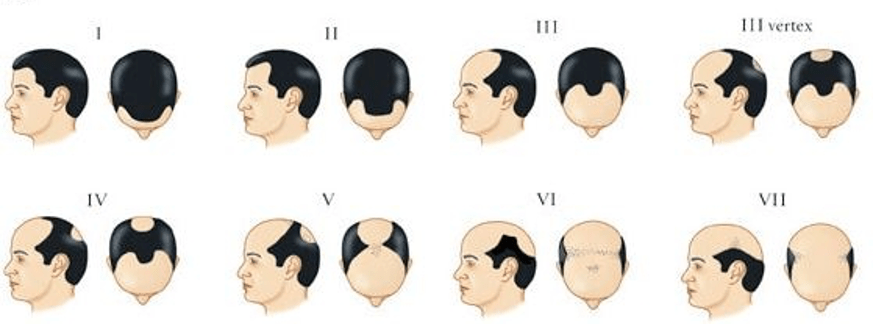My Norwood Class and Hair loss stage.
What is the Norwood Class of hair loss?
For Male Pattern Baldness or hair loss, Norwood system of classification is used to “grade” the starting (or reference) point and track progression of hair loss. Understanding the extent of hair loss as well as pattern of balding is essential when looking at treatment options.
The Norwood Scale is a seven-type scale used to categorize different stages of Male Pattern Baldness. We explain each class in the Norwood classification system below. To get a correct diagnosis for your hair loss, it is imperative to see a hair restoration expert. Only then will you have the right information to decide the right hair loss treatment.
How does hair loss look like under different Norwood scales and what treatment can you get?
Does the Norwood classification system sound confusing? Well, here is a visual representation to get you familiar.
According to the location and severity of Male Pattern Baldness, you can be classified in one of 7 stages.

1. Type I: Minimal hair loss.
If you are in this stage of hair loss, congratulations! You are doing well and no action is needed. Most men have a Norwood Type 1 before experiencing some hair loss as they age. Although uncommon, some lucky men maintain this hair type pattern for entire lives.
2. Type II. Insignificant hair loss at the temples.
Men with this type of hair loss display slight recession of the hairline at the temples, with no hair loss at the vertex. This stage is characterized by very early signs of the common M-, V- or U-shaped hairline beginning to occur.
At this stage, it would be a good idea to do a free face-to-face/ virtual consultation with a hair loss expert to start assessment of your scalp. Depending on the clinical view, you may or may not require preventive hair loss treatments.
3. Type III. The first hair loss stage that requires treatment.
Characterised usually by the “M”, “U” or the “V” shape, this common pattern of balding can take many different appearances depending on the severity. This is about as mild as hair loss gets, my friend.
At this stage, a small-sized hair transplant may be required. Preventive hair loss treatments become a must for you to keep enjoying what you have.
4. Type III vertex. Receding hairline and thinning hair on the vertex.
Some men with a Norwood Type II hairline also experience hair loss at the crown, or vertex. This is referred to as Norwood Type II vertex hair loss.
5. Type IV. Bigger pattern of hair loss on the vertex and hairline.
Here, the bald spot on the vertex starts to become prominent, but there is still a solid band of hair across the mid-scalp region, which separates the frontal hairline from the vertex.
A hair transplant is the only permanent hair correction possible to restore your lost hair. This will be coupled with Preventive hair loss treatments to avoid future loss of hair.
6. Type V. Hair loss patterns at both sites are bigger but a thin division line is still present.
The band between the front and rear sections of the hairline diminishes excessively in this stage of balding. The hair on the top of the head tends to be very sparse.
A hair transplant is the only permanent hair correction possible to restore your lost hair. This will be coupled with Preventive hair loss treatments to avoid future loss of hair.
7. Type VI. The bridge is gone but several strands of short fine hair may remain.
Men with Norwood Type VI hair loss have significant bald areas at the front of the scalp, the temples and the crown. The two areas of hair loss are joined, with either thinning or total loss of hair on the small band that previously separated the forehead and crown.
A hair transplant is the only permanent hair correction possible to restore your lost hair for this type.
8. Type VII. The most severe form of hair loss. Little hair on the front or top of the head.
This is the most severe type of hair loss. Men who develop a type this pattern usually begin the balding process in their late teens or early 20s, although there are plenty of exceptions to this general rule. At this stage, the front of the scalp, temples and crown no longer have any significant amount of hair, with only the horseshoe pattern of hair remaining.
Based on the quality of your donor, a hair transplant may be the only permanent hair correction possible to restore your lost hair.
What to do with my Norwood Class and hair loss type if I reside in Perth, Australia?
Don’t worry – hair loss can be treated at any stage if you live in Perth, Australia! Male Pattern baldness can start as early in one’s age and can be successfully treated with a variety of options including PRP Hair Treatment, Hair Mesotherapy, Laser Hair Growth Therapy and/ or DFI (Direct Follicle Insertion) Hair Transplant Technique.
Evolved Hair Restoration Clinic located in Perth, Australia offers a platinum degree of care to its patients, using international best practices and world class surgical and non-surgical solutions for all types of hair loss.
For consultation with hair loss specialist at Evolved Hair Restoration Clinic, please contact us at 1300 023 699 or book your appointment directly using the below link.




